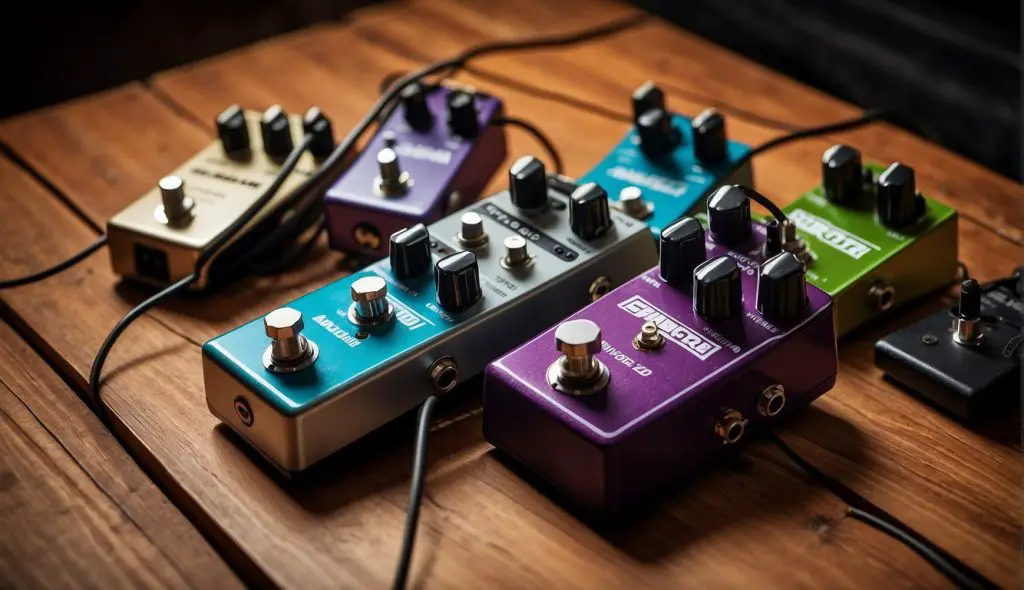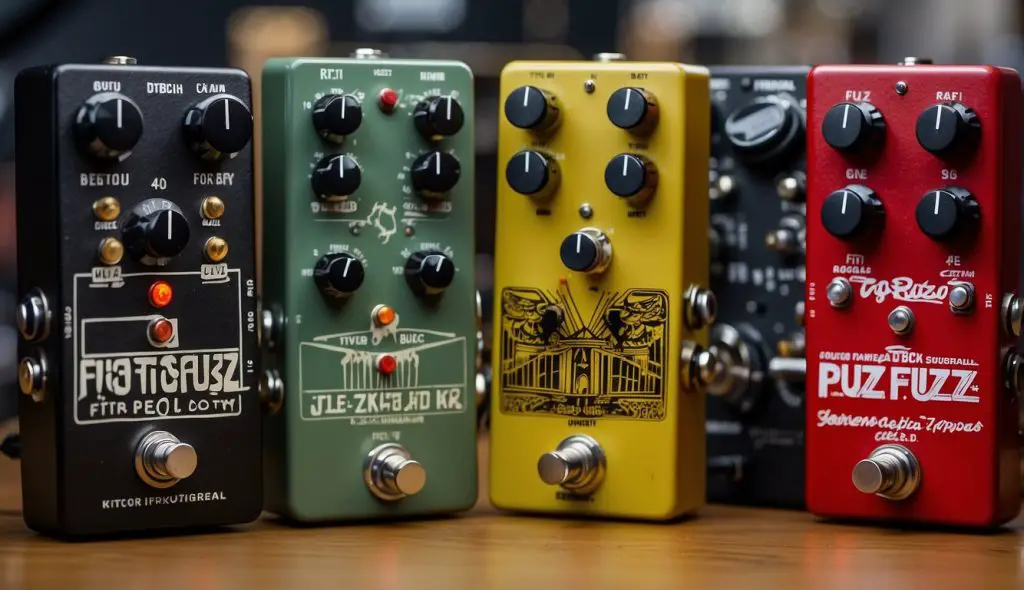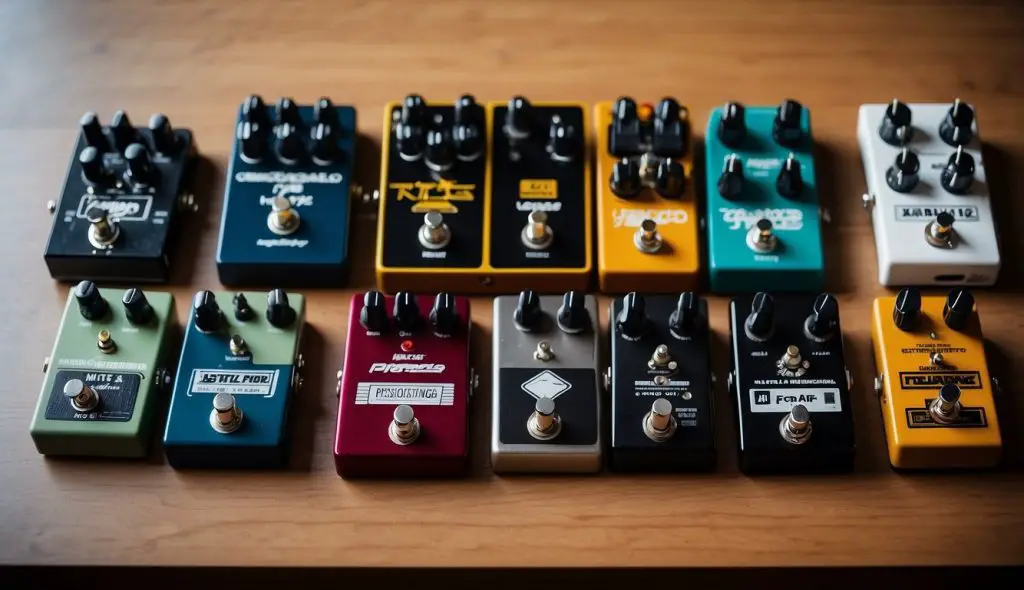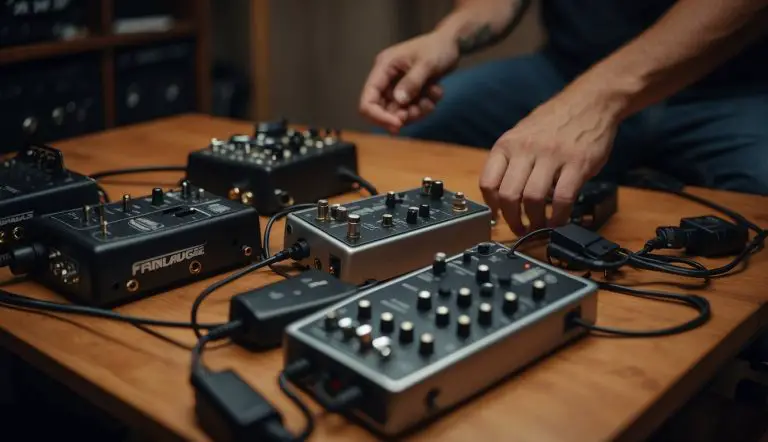What Are the Top 5 Best Fuzz Pedals?: Unleashing Iconic Guitar Tones
Fuzz pedals are an integral part of a guitarist’s arsenal, providing a classic effect that’s been pivotal in creating some of the most memorable tones in music history.
These pedals produce a warm, gritty, and sometimes aggressive distortion by shaping the guitar’s signal into a complex, rich harmonic texture.
In the landscape of guitar effects, the fuzz pedal offers a unique form of distortion that stands out for its analog warmth and sonic versatility.
With an array of options on the market in 2024, from the iconic square-wave snarl of the Big Muff to the multifaceted controls of modern units, choosing the right pedal to fit one’s musical style and technical demands has never been more exciting.

Choosing the top five fuzz pedals involves understanding their key characteristics and how they interact with different guitar rigs. Each pedal has its signature sound ranging from vintage warmth to modern aggressiveness, and many have evolved with additional controls for fine-tuning the fuzz effect.
Guitarists should consider aspects like the type of clipping, the impact of the pedal on the original guitar tone, and the flexibility of the unit in a live or studio setting.
A high-quality fuzz pedal can be a significant investment, and with many options available at different price points, knowing which features are most important for your playing style is crucial.
Key Takeaways
- Fuzz pedals are essential for creating distinctive and rich harmonic guitar tones.
- The selection of a fuzz pedal is based on personal style and technical requirements.
- Understanding fuzz pedal features is crucial for integrating one into your setup effectively.
Table of Contents
What Are The Key Features of Fuzz Pedals?

When choosing a fuzz pedal, understanding the distinction between fuzz, distortion, and overdrive is essential to achieving your desired sound.
Additionally, control options significantly impact tone shaping, allowing for a personalized touch to your guitar output.
Understanding Fuzz, Distortion, and Overdrive
Fuzz, distortion, and overdrive are all forms of gain that affect a guitar signal, but each provides unique characteristics. Fuzz is an extreme gain effect that creates a thick, saturated tone by drastically altering the wave shape of your guitar signal. This is often achieved through the use of silicon or germanium transistors.
Distortion, by contrast, provides a heavier amplification of the signal and alters it in a more controlled manner compared to the more unpredictable nature of fuzz.
Overdrive simulates the warm, driven sound produced when a tube amp is turned up to its limit. The key difference lies in how the pedal clips the signal, the texture, and the sustain it produces.
Control Options and Tone Shaping
The control options on a fuzz pedal are integral to shaping the tone and adapting the effect to your playing style. Most pedals include:
- Gain: Adjusts the amount of fuzz effect. Increasing gain leads to a more aggressive sound.
- EQ: This stands for equalization and allows you to balance low, mid, and high frequencies to either match the rest of your setup or stand out.
Fuzz pedals may also feature unique control options which reflect within their tone-shaping abilities. For instance, the Supersonic Fuzz Gun adopts a rather avant-garde approach, with controls that only loosely define their influence on the sound, allowing for a more experimental tone shaping.
The components used, such as silicon or germanium transistors, have a significant impact on the overall tonal quality. Generally, silicon transistors provide a brighter and more aggressive tone, while germanium transistors offer a warmer, vintage sound.
Adjustments to these controls can yield a diverse palette of sounds, from smooth fuzz to chaotic, wall-of-sound distortion.
The Top 5 Fuzz Pedals Overview
In my extensive experience with guitar tone shaping, I’ve found that fuzz pedals play a pivotal role in achieving a rich, distinctive sound. Below, I will break down some of the most esteemed fuzz pedals, focusing on their unique characteristics and the notable guitarists who have utilized them.
Big Muff Series
The Big Muff series has been a staple on pedalboards since the late 1960s. Its signature sound ranges from a warm sustain to a more aggressive tone. The Electro-Harmonix Big Muff Pi is especially revered for its association with legendary musicians like David Gilmour, whose solos often sing with the creamy, violin-like sustain provided by the Big Muff.
There are several variations, including the Op-Amp Big Muff, which is celebrated for its smooth yet robust fuzz that stays articulate even at high gain settings.
Fuzz Face Models
Featuring prominently in the history of fuzz is the Fuzz Face, an iconic pedal that has shaped the sounds of musicians like Jimi Hendrix. This pedal is known for its use of either silicon or germanium transistors, each contributing a different character: silicon typically provides a brighter and more aggressive fuzz, while germanium offers a warmer, more vintage sound.
The Fuzz Face’s dynamic response to playing touch and the guitar’s volume control makes it a top choice for those seeking an expressive fuzz tone.
EarthQuaker Devices
EarthQuaker Devices is a modern pedal manufacturer known for crafting innovative effects. Their fuzz pedals, such as the Hizumitas and the Erupter, stand out for their unique sound sculpting capabilities. They serve up a wide range of sonic textures, from subtle fuzz to a more pronounced, saturated fuzz tone, making them versatile pedals on my list of best fuzz pedals.
Other Notable Mentions
Among other notable mentions are the Way Huge Swollen Pickle MkIIs and Beetronics Vezzpa, which offer extensive tonal shaping possibilities and can cater to both traditional and avant-garde fuzz tones. These pedals are designed to cater to a variety of genres and playing styles, expanding the conventional boundaries of fuzz with their tweakable parameters and wide-ranging sonic palettes.
Selecting a Fuzz Pedal for Your Style
When I choose a fuzz pedal, I look for one that complements my musical style and offers the right balance of characteristics. These choices let me shape my tone to fit various genres and personalize my sound.
Matching Pedals with Musical Genres
Rock and Psychedelic: For classic genres, I often turn to a pedal like the Big Muff, known for its warm sustain, perfect for mimicking the tones of famous bands like Pink Floyd.
Garage and Punk Rock: A pedal with raw and aggressive characteristics, such as the Z.Vex Fuzz Factory, matches well with the energy required for these styles.
Blues and Vintage: For music that channels a time-honored feel, I prefer pedals like the Fuzz Face that offer a smoother, more rounded fuzz sound inspiring those bluesy leads.
Experimental and Alternative: The Way Huge Swollen Pickle MkIIS offers extensive tweakability perfect for genres that thrive on unique, customized sounds.
Key Parameters for Personalization
Knobs and Controls: It’s essential to have a pedal with responsive knobs. This allows me to refine the fuzz intensity, tone, and volume to mix into the band’s sound seamlessly or stand out for solos.
- Volume: Controls the output level.
- Tone: Shapes the color of the fuzz effect.
- Sustain/Gain: Adjusts the length of sustain and the thickness of the fuzz.
Switches and Options: Pedals with switchable options like MXR M236 Variac Fuzz’s big/tight switch let me adjust the characteristic of the fuzz, giving me a more versatile sound.
By considering these factors, I optimize my setup for any performance or recording, ensuring my fuzz pedal enhances rather than masks my guitar’s voice.
Fuzz Pedal Usage Tips
When employing fuzz pedals, the key to unlocking their full potential lies in understanding how to properly integrate them with other effects on your pedalboard and ensuring they’re optimized for performance.
Integration with Other Effects
I recommend placing your fuzz pedal early in the signal chain to preserve its character. Fuzz pedals often interact best with a clean signal to deliver their full sonic impact.
For instance, when integrating with a wah pedal, I find it works better if the fuzz comes after the wah to prevent signal loading issues, which can sometimes cause a loss of the fuzz effect’s tonal aggression.
- Order matters: Keep modulation and time-based effects, like chorus or delay, after the fuzz.
- Experiment with combinations: Some overdrive pedals can complement a fuzz pedal when placed after it, providing a rich and textured tone.
Maximizing Pedal Performance
Your fuzz pedal’s performance relies heavily on its power supply. It is essential to use the correct voltage and current to prevent any unwanted noise or damage to the pedal. Here’s what I’ve discovered for optimal performance:
- Power Supply: Use isolated power supplies to minimize hum and noise.
- Knob Settings: Start with lower settings on your fuzz pedal’s knobs and gradually increase to find the sweet spot without causing unwanted feedback or excess noise.
- Options: Explore different fuzz pedals as they offer various tonal options from vintage warmth to modern sizzle.
Remember, fine-tuning the knobs to your personal taste and the context of your pedalboard setup is key to achieving the best results.
Fuzz Pedal Reviews and Recommendations
In my assessment of the latest fuzz pedals on the market, I focus on expert insights and value for your money. These two key factors will guide you through the diverse range of options available.
Professional Opinions
Electro-Harmonix Op Amp Big Muff
- Durability: Renowned for its solid build, ensuring it lasts on the road.
- Tone: Delivers a classic and versatile fuzz sound adored by professionals.
Z.Vex Fuzz Factory
- Customization: Offers extensive tweaking to achieve unique sounds.
- Review Consensus: Widely appreciated for its oscillation capabilities and distinctive character.
EarthQuaker Devices Hizumitas
- Tonal Range: Known for a wide range of fuzz textures from subtle to extreme.
- Professional Use: Favoured by many for its responsiveness and exceptional sonic quality.
Boss FZ-1W
- Modern Features: Combines vintage sounds with contemporary reliability.
- Reviews: Positive approval for its user-friendliness and tonal versatility.
Death By Audio Supersonic Fuzz Gun
- Sound: Capable of otherworldly fuzz tones, pushing the boundaries of traditional fuzz.
- Reception: Revered by experimental players for its innovative design.
Cost-to-Value Considerations
Walrus Audio Eons
- Price Point: Higher investment, but justified by its five distinct fuzz circuits.
- Value: Considered a worthwhile addition for those seeking an all-in-one fuzz solution.
Durable Options
- Most pedals I’ve reviewed are ruggedly constructed, with the EarthQuaker Devices Hizumitas and Boss FZ-1W standing out for longevity.
Price Versus Options
- Boss FZ-1W: Offers a competitive price combined with Boss’s reputation for durable, quality pedals.
- Death By Audio Supersonic Fuzz Gun: Its unique tones justify the higher price for players looking for non-traditional sounds.
- Z.Vex Fuzz Factory: Though on the pricier side, the array of options it offers makes it a solid investment against its competitors.
Frequently Asked Questions

In this section, I’ll address some common inquiries about the top fuzz pedals available on the market, to help you make an informed decision for your guitar setup.
Which fuzz pedals are considered the top choices for guitar players?
In 2024, fuzz pedals like the Electro-Harmonix Op Amp Big Muff, Z.Vex Fuzz Factory, and Way Huge Swollen Pickle MkIIS are among the top choices for guitar players, known for their quality and tonal versatility.
Which fuzz pedal is often recommended for achieving a classic blues sound?
For a classic blues sound, guitarists often turn to the Fuzz Face, known for its warm, vintage sound that can emulate the tones associated with artists like Jimi Hendrix.
What are some highly regarded boutique fuzz pedals in the market?
Boutique manufacturers like Beetronics with their Vezzpa, and Earthquaker Devices with the Hizumitas, offer unique and highly regarded fuzz pedals that stand out in the market for their craftsmanship and distinct tonal character.
What are the preferred fuzz pedals for metal guitarists?
Metal guitarists tend to prefer fuzz pedals that offer a heavier and more aggressive tone. Pedals like the Electro-Harmonix Ripped Speaker and the Walrus Audio Eons are popular choices for achieving that powerful metal sound.
Which fuzz pedals did legendary guitarists like Jimi Hendrix and Keith Richards use?
Jimi Hendrix was famously associated with the Fuzz Face pedal, which played a pivotal role in shaping his iconic sound.
Keith Richards initially used a Maestro Fuzz-Tone, most notably on the Rolling Stones’ “(I Can’t Get No) Satisfaction.”
How do modern fuzz pedals compare to the best ones released in the past?
Modern fuzz pedals leverage advancements in technology to offer a broader range of sounds and features while still capturing the essence of classic pedals.
They provide improved reliability, more tonal options, and greater flexibility to adapt to various musical styles.


